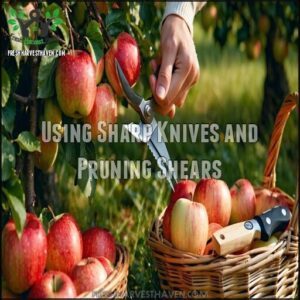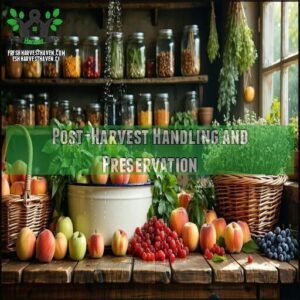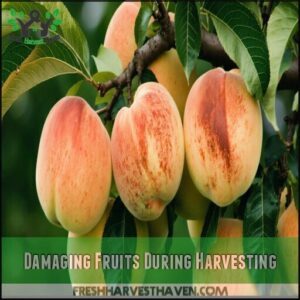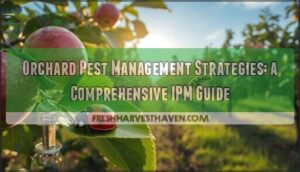This site is supported by our readers. We may earn a commission, at no cost to you, if you purchase through links.

Timing is key to getting the best flavor and texture.
You’ll want to check the fruit’s color, texture, and other signs that signal it’s ready.
For example, a ripe strawberry is typically bright red and slightly soft.
Knowing when to harvest different fruits can be tricky, but don’t worry, you’ll get the hang of it.
Now, let’s get picking – and discover the secrets to harvesting like a pro.
Table Of Contents
- Key Takeaways
- Choosing The Right Harvest Time
- Harvesting Techniques for Different Fruits
- Post-Harvest Handling and Preservation
- Common Mistakes to Avoid When Harvesting Fruits
- Maximizing Fruit Quality and Shelf Life
- Frequently Asked Questions (FAQs)
- When should fruits be harvested?
- How can you tell if a fruit is ready for harvest?
- How do you know when a crop is ready to harvest?
- When should fruits be picked?
- What month is best for fruit picking?
- How do you know when your crop is ready to harvest?
- How do you harvest different fruits?
- When is the best time to harvest fruit?
- When is the best time to eat fruits?
- When is the best time to harvest vegetables?
- Conclusion
Key Takeaways
- You’ll want to check the fruit’s color, texture, and other signs that signal it’s ready to harvest, like a ripe strawberry being bright red and slightly soft.
- To determine the perfect harvest time, you’ll need to consider factors like weather, soil quality, yard location, and crop variety, as they all affect the fruit’s ripeness.
- When harvesting, you’ll need to use sharp tools, gently tug and twist fruits, and cut stems and vines to minimize damage and ensure efficient harvesting methods.
- After harvesting, you’ll want to wash and store your fruits properly, considering methods like freezing, canning, or drying to keep them fresh for a longer period and maintain their nutritional benefits.
Choosing The Right Harvest Time
You’re about to learn how to choose the right harvest time for your fruits, and it’s easier than you think.
Mastering the perfect harvest time is easier than you think
By understanding the factors that affect harvest time, you’ll be able to pick your fruits at the perfect moment, ensuring they’re sweet and ripe.
Factors Affecting Harvest Time
Your fruit harvesting guide depends on more than luck; it’s about nature and how you nurture your plants.
Here’s what affects determining fruit ripeness:
- Weather Influence: Rainy springs or hot summers change things.
- Soil Quality: Good soil makes for perfect ripe fruit indicators.
- Yard Location: Sunny spots mean faster ripening.
- Crop Variety: Different fruits, different schedules.
Master these, and you’ll know when to harvest different fruits. It’s all about understanding harvest readiness signs.
Understanding Fruit Ripening Process
You’re about to discover the secret to perfect harvests.
Ethylene production triggers cell wall softening, increasing sugar content and aroma development.
As fruits ripen, they undergo distinct maturity stages, signaled by color changes and ripening schedules.
Understanding the fruit ripening process helps you determine harvest readiness signs, ensuring you pick at the peak of flavor and texture, with each fruit variety having its unique ripening timeline.
Common Signs of Fruit Readiness
Now that you know about the fruit ripening process, how do you know when to pick? Spotting ripe fruits is like cracking nature’s code!
Here’s your cheat sheet for perfect picks:
- Color indicators: Look for berries glowing or tomatoes blushing.
- Texture changes: A gentle squeeze reveals just-right softness.
- Aroma development: Trust your nose—ripe fruits share sweet whispers.
- Easy detachment: They’ll twist off easily.
Use these ripeness signs for juicy rewards. Daily checks, though—today’s firm fruit might be tomorrow’s snack! Knowing these fruit maturity stages helps perfect your harvest timing.
These ripeness signs will help you pick at the right fruit maturity. Different fruits require understanding fruit harvest timing for superior flavor.
Harvesting Techniques for Different Fruits
You’re now ready to learn the best harvesting techniques for different fruits.
Master the art of harvesting for a bountiful and delicious fruit yield
By using sharp knives, gently tugging and twisting fruits, and cutting stems and vines, you’ll be able to harvest your fruits like a pro.
You’ll be able to enjoy them at their best.
Using Sharp Knives and Pruning Shears
You’ll need sharp knives and pruning shears for harvesting.
| Tool | Blade Sharpness | Cut Placement |
|---|---|---|
| Pruning Shears | High | Precise |
| Garden Knife | Medium | Varied |
| Lopping Shears | Low | Coarse |
| Harvest Shears | High | Delicate |
Sanitize tools, maintain blade sharpness, and master cutting techniques to minimize bruising and guarantee efficient harvesting methods.
Consider the various shear types available for specific tasks, and note the importance of efficient harvesting methods.
Gently Tugging and Twisting Fruits
Now that you’re armed with the right cutting tools, let’s talk about feeling for ripeness. Ever wonder how to tell when a fruit is ready to pick without causing damage?
Here’s how to test for fruit detachment ease:
- Gently cup the fruit, then twist at the stem separation point. If it releases easily, it’s ripe! If not, wait a bit longer.
Remember, minimizing fruit damage is key. A ripe fruit should practically fall into your hand during fruit picking season. This twist angle guarantees a clean break. Use these harvest indicators to enjoy the fruits of your labor! Mastering gentle fruit detachment is a game-changer for harvesting fruits. To maintain quality, remember that gentle handling prevents bruising helps to safeguard the produce.
Cutting Stems and Vines
You’re harvesting fruits, so use sharp pruning tools for smooth cuts.
Proper vine management means precision cutting to avoid damage.
Cut stems at the right spot to preserve plant health.
Sanitize your tools to prevent disease.
Consider the fruit picking season and harvest techniques, like harvesting berries tips or melon harvest time, to guarantee the best results.
Use stem cutting tools correctly to seal wounds and maintain vine health, especially during peak harvesting seasons.
Post-Harvest Handling and Preservation
You’ve harvested your fruits, now it’s time to think about how to handle and preserve them.
You’ll want to wash and store them properly, and consider methods like freezing, canning, or drying to keep them fresh for a longer period.
Washing and Cleaning Fruits
Now that you’ve harvested your fruits, it’s time to clean them up. You’ll want to use lukewarm water and gentle handling to avoid bruising. For extended storage, consider vacuum sealing fruit after washing.
- Use the right water temperature
- Choose gentle cleaning solutions
- Select proper drying methods
- Follow sanitary practices
- Remove residue for better fruit quality.
For sturdy fruits, scrub with a soft fruit brushing tool, while delicate berries can be dipped in water instead. Dry them completely with a clean cotton towel to prevent spoilage and inspect carefully for any missed patches, ensuring better fruit quality and proper drying methods. This process helps in gentle handling of the fruits.
Storing Fruits Properly
You’ve cleaned your fruits, now store them properly.
Keep ethylene-producing fruits like apples separate from berries. Manage temperature, humidity, and ethylene levels to prevent spoilage and extend shelf life.
Ideal storage conditions vary, but most fruits prefer cool, dry spots.
Proper post-harvest handling and storage duration can substantially impact fruit quality, so control humidity levels and temperature to maintain freshness.
Freezing, Canning, and Drying Fruits
As you explore fruit preservation, consider Freezing Techniques, Canning Safety, and Drying Methods.
Freezing retains nutrients, while canning requires proper sterilization. Drying Methods, like dehydration, are great for healthy snacks.
For long-term storage, freezing and canning are best, with a Storage Duration of up to 5 years for canning.
Proper fruit storage and handling guarantee a high Nutritional Impact. Efficient preservation may require specialized freezing equipment.
By mastering these techniques, you’ll enjoy your harvest all year round, savoring the taste and nutritional benefits of your preserved fruits, and make the most of your fruit preservation efforts.
Common Mistakes to Avoid When Harvesting Fruits
You’re about to learn how to avoid common mistakes when harvesting fruits, which can make all the difference in their taste and quality.
By being aware of these mistakes, you can guarantee you’re picking your fruits at the right time and handling them with care to enjoy the best results.
Harvesting Fruits Too Early or Too Late
You’re on a mission to master fruit harvesting. Timing is key to revealing maximum sweetness and flavor development.
Harvesting too early or late affects nutrient content and texture changes. To avoid spoilage risk, check for ripeness indicators daily.
- Monitor flavor development
- Track texture changes
- Optimize crop readiness for maximum sweetness
Damaging Fruits During Harvesting
You’ve avoided harvesting fruits too early or too late, now it’s time to think about handling them with care.
Bruising prevention is key to a successful harvest. Use sharp tools to minimize scratch and tear damage.
Gentle handling prevents bacterial spread, so sanitize your tools and handle fruits like treasures.
Proper fruit handling and harvest planning can make all the difference, reducing fruit damage and harvesting mistakes.
By being mindful of your techniques, you can enjoy a healthy and abundant harvest.
Not Storing Fruits Properly
Bruising your harvest is bad, but improper storage is worse. You don’t want to watch your hard-earned fruit spoil! Let’s fix that with easy fruit storage methods.
- Separate ethylene producers like bananas.
- Maintain proper humidity levels; too low, they shrivel!
- Practice temperature control; steady temps are key.
- Inspect daily, removing overripe fruit to prevent cross-contamination.
Extending fruit shelf life is easy. Apples love the fridge, increasing storage duration, but bananas prefer the counter. Great fruit handling saves your harvest. Master post harvest handling and proper optimal storage and keep your fruit fresh!
Maximizing Fruit Quality and Shelf Life
You’re almost there – now it’s time to maximize your fruit’s quality and shelf life.
By monitoring ripeness, avoiding over-handling, and maintaining ideal storage conditions, you can enjoy your fresh picks for a longer period, which helps to maintain the overall freshness.
Monitoring Fruit Ripeness
You’re now monitoring fruit ripeness.
Look for visual cues like color changes, and use texture analysis by gently pressing the fruit.
Aroma detection also helps, as ripe fruit often emits a sweet scent.
Try sampling methods to check for maturity, and observe ripening stages to determine the perfect time to pick your fruit.
Avoiding Over-Handling Fruits
You’ve got to be gentle with your fruit! Over-handling can lead to bruising and bacterial spread. So, use gentle techniques. Clean hands and proper tools are key.
Here’s how to avoid damaging your precious harvest:
- Always support fruits as you pick them.
- A gentle squeeze tells you when it’s ripe.
- Use proper tools for clean cuts.
Good fruit handling techniques are important. Sweet scents signal peak ripeness. Remember, careful fruit harvesting methods and postharvest handling keep your fruit fresh!
Maintaining Optimal Storage Conditions
To keep your fruits fresh, focus on temperature control and humidity levels.
Here are some tips:
- Use breathable containers
- Keep fridge at 32-55°F
- Separate ethylene-producers
- Check fruits often for spoilage prevention, ensuring good postharvest handling and longer shelf life.
Proper storage can be achieved with specialized fruit containers, which is crucial for proper storage and maintaining the freshness of your fruits, thus ensuring a longer shelf life.
Frequently Asked Questions (FAQs)
When should fruits be harvested?
You should harvest fruits when they’re fully ripe, as indicated by color, texture, and aroma, to guarantee the best taste and texture, usually in the early morning for best results.
How can you tell if a fruit is ready for harvest?
You can tell if a fruit is ready by checking its color, texture, and aroma, and gently tugging on it to see if it comes off the stem easily.
How do you know when a crop is ready to harvest?
You’ll be a million times better at harvesting when you check for color, texture, and aroma, and gently tug on the fruit to see if it’s ready to come off!
When should fruits be picked?
You pick fruits when they’re ripe, as signaled by color, texture, and aroma changes, to guarantee maximum sweetness and flavor, usually in the morning for best results and quality.
What month is best for fruit picking?
You’ll find the best month for fruit picking varies, but generally, it’s late summer to early fall, depending on the type of fruit and your location’s climate conditions.
How do you know when your crop is ready to harvest?
You’ll know your crop is ready when it’s heavy, colorful, and slightly soft, giving off a sweet aroma, signaling it’s time to harvest and enjoy the fruits of your labor.
How do you harvest different fruits?
You harvest different fruits by gently twisting, cutting, or pulling them from the plant, depending on the fruit type, such as strawberries, apples, or melons, at peak ripeness.
When is the best time to harvest fruit?
You’ll want to harvest fruit when it’s ripe, as this guarantees maximum sweetness and texture, so check for color, texture, and aroma to determine the best time.
When is the best time to eat fruits?
You savor fruits at their peak ripeness, when flavors and textures are most vibrant, typically soon after harvesting, to enjoy their sweetness and nutritional benefits.
When is the best time to harvest vegetables?
You’ll find most veggies are ready by late summer, so check daily and pick at peak ripeness for best taste and texture, usually in the early morning.
Conclusion
Now you’re the master of your fruit domain, and timing is key.
You’ve got the lowdown on when to harvest different fruits, so go ahead and pick like a pro.
Remember, knowing when to harvest different fruits can be tricky, but with practice, you’ll be a fruit-picking rockstar, and your harvest will be the icing on the cake, yielding the best flavor and texture every time.












